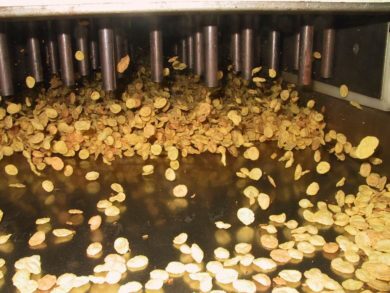According to a report by BCC, a market research firm, the global market for food processing and packaging equipment will total $35.1 billion by 2020. This prediction represents a significant compound annual growth rate (CAGR) of 4.2 percent through the forecast period. But the question is, how and why is this growth happening?
Until the industrial revolution, 95 percent of American families lived in rural areas and relied on meats and produce that were locally grown and harvested. But the industrial revolution caused a population shift to become more urban, and the need for shipping and packaging of food into the growing cities spurred the need for industrialized methods of mass production that radically transformed the food system that we know today.
Modern Food Processing Equipment
However, more than one-hundred-twenty years later, we are finding ourselves in a second industrial revolution. A revolution of faster, more efficient automation equipment. As a company with a foundation in innovation, General Kinematics has worked to stay at the forefront of the revolution with innovative automated equipment.
Today, food that is grown in one area is sent to processing plants in another area, and then shipped to factories where fresh, canned, or frozen food products are produced. These food products are then sent hundreds or even thousands of miles away for consumption domestically and around the world.
As a result, the food processing sector has been transformed into a high-volume industry. Driven by stricter Food and Drug Administration (FDA) regulatory standards for food quality and purity, consumer demand, and economics, the new food processing and packaging equipment is designed to operate to meet sanitary regulations, work faster than human production, and produce a more consistent end product. This processing and packaging technology is now focusing on retaining maximum nutrients and sensory properties while increasing the shelf life of food without any adverse effect on food quality or taste.
An Ever-Growing Market
BCC predicts, even more, growth in the food processing and packaging sector over the next several years, and attributes that growth to an increase in families with working parents who desire processed food and drink products for convenience. These changes in consumer behavior will require equipment to meet the demands of new safety and quality standards, as well as the industry’s need to reduce the size of its workforce and streamline production processes.
General Kinematics’ bulk processing and material handling equipment, such as the Fluid bed Processors, Vibrating Conveyors, and grinding drums, are providing the food processing industry with state of the art automation equipment that will meet demands.
According to the BCC report, the food packaging market is expected to grow from $14.4 billion in 2015 to nearly $17.3 billion in 2020, demonstrating a five-year CAGR of 3.6 percent. The food processing market should reach $11.2 billion and $14.2 billion in 2015 and 2020, respectively, at a five-year CAGR of 4.8 percent.
In addition, a new market research report from PMMI, The Association for Packaging and Processing Technologies, agrees with the BCC report and suggests that the move toward healthier and more convenient options is an opportunity for OEMs. The report, called 2017 Trends in Food Processing Operations, analyzes intelligence from 40 interviews and 150 references. PMMI’s findings mirror the BCC report and reveal that markets, channels, and technology are changing the way consumers will purchase food over the next 15 years, and predict that this may bring significant change to manufacturing and sourcing.
Companies participating in the 2017 survey indicated that:
– Nearly half will be spending MORE on capital equipment in the next 12 to 24 months.
– Half the companies forecast needing processing equipment, and 3 of 4 companies will be looking for packaging equipment.
– Food processing manufacturers source two-thirds of their equipment from U.S. OEMs due to faster delivery, parts availability, and service support.
– Top attributes when procuring equipment are cost and quality.
– Over half of food manufacturers use customized equipment and look to the OEM for integration
– Half of the companies are focused on increasing the level of automation in the next three to five years
– Robotics are now used in 30% of processing operations and 94% of packaging operations, with both areas predicting increased usage.
– 3 of 4 companies measure overall equipment effectiveness (OEE) and look for reliable machinery to improve uptime.
– End users recommend processing machinery improvements that focus on cleanability, operator safety, and flexibility in changeover.
– Technology improvements include:
1. Faster read times for vision equipment
2. Self-diagnostics for preventive maintenance
3. Connectivity-ready
Beyond flexibility, safety is a priority. With that in mind, here are some of the important features of future machinery:
– Must comply with stringent food safety regulations.
– Highly selective sorting to reduce food waste.
– Smaller batch processing machinery and more compact manufacturing.
– Inspection equipment for detection and separation of ever smaller foreign particles.
– Highly flexible equipment with easier changeover.
– Greater automation equipment that combines a number of operations into one.
– Machinery that reduces and conserves energy usage.
Getting the Most from Your Food Processing Equipment
It is interesting to note that as advanced as food processing and packaging equipment has become, end users are demanding even more capability and flexibility from the next generation of equipment. It is not surprising that many of these new machines will be adapted to specific needs, opening the door to opportunity for imaginative OEMs.
To that end, we believe that one of the best ways to justify investing in new equipment is to know it is going to do the job you need it to do before you invest. GK operates a full-time R&D Laboratory that is staffed with decades of product trial experience that can quickly determine the best GK technology to improve your process.
If you have questions about how General Kinematics equipment can be integrated into your manufacturing process, send an email to info@GeneralKinematics.com or call 815-455-3222.









